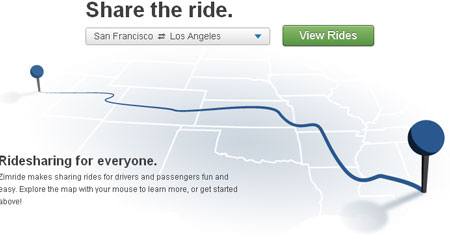
By Colleen Taylor
Zimride, the startup that allows people to arrange shared car rides together, has been doing quite well within semi-private, paid networks since its 2007 launch. Starting Wednesday, the company is set to reach a much bigger audience with two new features: Its first public ride-sharing route, and a new in-app payment system.
tecenter”>
Here is how Zimride has worked so far: It’s a software-as-a-service platform for allowing people to schedule shared rides within their existing social networks. It has proven to be popular: There are currently 110 Zimride communites at universities and companies across 30 states in the US, allowing co-workers and fellow students to carpool for things from daily commutes to hundred-plus- mile trips home for the holidays.
Taking Zimride public
On Wednesday, Zimride is launching its first promoted public route, which it’s calling the “sunshine route,” from San Francisco to Los Angeles. Now all Zimride users, regardless of their corporate or university network, can use Zimride to arrange a ride between San Francisco and Los Angeles. And passengers can now compensate drivers using a new in-app payment platform, rather than arranging the cash payment during the trip.
In an interview this week, Zimride co-founder John Zimmer told me the new public routes are actually what the company has been working toward since day one. “It’s always been the plan to make Zimride a new form of transportation for everybody. Network-based silos can only get you so far,” he said.
But the initial focus on specific networks had one big thing going for it: It allowed Zimride to scale up with paying customers. Universities and workplaces pay fees to subscribe to Zimride as a software-as-a-service, since it saves them money they’d otherwise have to spend on more parking lots. This revenue stream allowed Zimride to refine its business model in a relatively smaller space while making money.
Enough money, in fact, to support a San Francisco-based staff of 16 employees, mostly with its own revenue. (The company has taken on a total of about $1.5 million in seed funding since its inception.) Zimride is now ready to swing for the fences. “Now we have this critical mass of 110 partners and networks, so we have a huge proof of concept that this works,” Zimmer said.
A proper payment system
In conjunction with the public route launch, Zimride is also launching its own payment platform to allow passengers to pay drivers within the Zimride app. This feature came about as a result of requests from Zimride users, who complained that negotiating in-person money exchanges during car rides was too awkward, Zimmer told me.
Of course, the payment platform also gives Zimride the opportunity to collect fees on all financial transactions the site helps facilitate, but at launch the company is not taking any commission on payments. Zimride is still ironing out its eventual fee plan, but right now it’s planning to eventually take a 10 percent cut from the transactions it processes.
In all, the new features show that Zimride is primed to make the jump from beloved network-based app to full-on public product. Will people be ready to share their cars with relative strangers? With gas prices going up and increasingly crowded highways, there’s no time like the present to find out.
Article courtesy of gigaom.com

